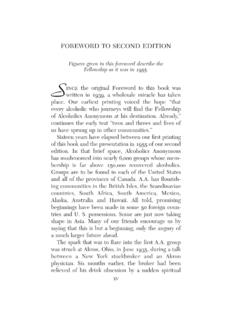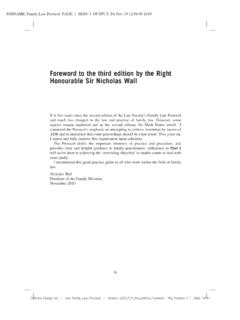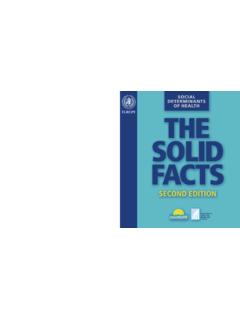Transcription of Second Edition - Malaysian Qualifications Agency
1 ISecond EditioniiCode of Practice for Institutional AuditFirst Published June 2008 Second Edition February 2009 ISBN 978-983-44015-0-4 2009 Agensi Kelayakan Malaysia ( Malaysian Qualifications Agency , MQA)Level 14B, Menara PKNS-PJNo. 17, Jalan Yong Shook Lin 46050 Petaling JayaSelangor Darul Ehsan MalaysiaTel: +603 7968 7002 Fax: +603 7956 iiiForeword to the First Edition viiGlossary ixAbbreviations xiList of Tables xii Section 1: An Overview of Quality Assurance of Malaysian Higher Education INTRODUCTION 3 1. The Malaysian Qualifications Agency 3 2. The Council of Malaysian Qualifications Agency 3 3. Committees 4 The Accreditation Committees The Institutional Audit Committee The Equivalency Committee The Standards Committees 4. The Malaysian Qualifications Framework 5 5.
2 Approaches to Quality Assurance 6 6. The Malaysian Qualifications Register 6 7. The Quality Assurance Guidelines 7 Quality Assurance Documents Areas of Evaluation 8. Programme Accreditation 8 The Accreditation Report The Accreditation Summary Report 9. Institutional Audit 9 Report to the Higher Education Provider: Continual Quality Improvement Report to the Ministry of Higher Education Report for the Public Section 2: Guidelines on Criteria and Standards for Higher Education Providers INTRODUCTION 13 Area 1: Vision, Mission, Education Goals and Learning Outcomes 15 Statement of Vision, Mission and Educational Goals Participation in the Formulation of Vision, Mission and Educational Goals Academic Autonomy Learning Outcomes Area 2.
3 Curriculum Design and Delivery 18 Curriculum Design and Teaching-Learning MethodsList of Contentsiv Curriculum Content and Structure Management of Programmes Linkages with External Stakeholders Area 3: Assessment of Students 21 Relationship Between Assessment and Learning Assessment Methods Management of Student Assessment Area 4: Student Selection and Support Services 23 Admission and Selection Articulation Regulations, Credit Transfer and Credit Exemption Transfer of Students Student Support Services and Co-Curricular Activities Student Representation and Participation Alumni Area 5: Academic Staff 28 Recruitment and Management Service and Development Area 6: Educational Resources 30 Physical Facilities Research and Development Educational Expertise Educational Exchanges Financial Allocation Area 7: Programme Monitoring and Review 34 Mechanisms for Programme Monitoring and Review Involvement of Stakeholders Area 8: Leadership, Governance and Administration 36 Governance Institutional and Academic Leadership Administrative and Management Staff Academic Records Interaction with External Sectors Area 9: Continual Quality Improvement 39 Quality Improvement Section 3.
4 Submission for Institutional Audit INTRODUCTION 43 The Documentation Required 43 Part A: General Information About the Higher Education Provider 45 Part B: Information on the Nine Areas of Evaluation for Quality Assurance 50 Part C: Self-Review Report 77 vSection 4: The Institutional Audit INTRODUCTION 81 The Internal Quality Audit 81 The Internal Quality Audit Task Force Data Collection The Self-Review Portfolio (SRP) Institutional Audit: The External Audit 83 The Role Players Support Facilities The Audit Timeline The Audit Management Meeting The Preparatory Meeting The Planning Visit The Audit Visit The Oral Exit Report The Draft Institutional Audit Report The Institutional Audit Report Findings and Judgments Appeal Follow Up Section 5.
5 The Panel of Auditors INTRODUCTION 99 Appointment of the Members of an Audit Panel 99 Personal and General Attributes of Auditors Responsibilities of the Auditors Conflict of Interest 101 The Audit Panel 102 The Chairperson The Secretary The MQA Officer The Audit Trail 104 Before the Audit Visit Preparatory Meeting During the Audit Visit After the Audit Visit The Institutional Audit Report 109 Section 6: Guidelines for Preparing the Institutional Audit Report INTRODUCTION 113 1. The Cover Page 113vi 2. Table of Contents 113 3. Memorandum 113 4. Introduction and Composition of the Audit Panel 114 5. Abstract 114 6. Summary of Panel of Auditors Findings 115 7.
6 Previous Quality Assurance or Accreditation Assessments and Progress 117 Reports 8. The Self-Review Portfolio 117 9. Background of the Higher Education Provider 117 10. Report on the Higher Education Provider in Relation to the Nine Areas 117 of Evaluation APPENDICES Appendix 1: The Quality Assurance Process: An Overview 141 Appendix 2: General Comparison of Programme Accreditation and 143 Institutional Audit Process Appendix 3: Flow Chart for Institutional Audit Process 145viiForeword to the First EditionThe National Accreditation Board (Lembaga Akreditasi Negara, LAN) was established in 1997 to quality assure private higher education in Malaysia. Quality assurance of public higher education institutions was entrusted to the Quality Assurance Division (QAD) of the Ministry of Higher Education.
7 In 2005, the Malaysian Cabinet decided to merge LAN and QAD into a single quality assurance body. Thus, the Malaysian Qualifications Agency (MQA) was born under the Malaysian Qualifications Agency Act 2007. Concurrently, the Malaysian Qualifications Framework (MQF) was developed to unify and harmonise all Malaysian Qualifications . This development is in line with Malaysia s long term development plans as well as the Ministry of Higher Education s aspiration for the transformation of higher education in the country. These reflect a maturing Malaysian higher education system that encourages providers to adopt a more systematic and holistic approach in the provision of quality education. Assigned the task to ensure quality in higher education in the spirit of the MQF, the MQA has developed a series of guidelines, standards and codes of practice to assist the higher education providers enhance their academic performance and institutional effectiveness.
8 Key among these are the Code of Practice for Programme Accreditation (COPPA) and Code of Practice for Institutional Audit (COPIA). COPPA and COPIA are intended to be useful guides for providers of higher education, quality assurance auditors, officers of the MQA, policy makers, professional bodies and other stakeholders engaged in higher education. The Codes, not only contain an overview of the Malaysian quality assurance system for higher education, they also guide the reader on the nine areas of evaluation for quality assurance as well as the two levels of standards -- benchmarked and enhanced standards -- that underline them. In addition, the two documents provide guidance for internal quality review to be conducted by the institution and external audit to be conducted by the MQA s panel of assessors.
9 They also include site visit schedules as well as guidelines on report writing. COPPA and COPIA have been developed by bringing together the good practices adopted by the QAD and LAN, with inputs from experts and stakeholders via a series of focus group discussions. They were also benchmarked against international best practices. In doing this, references have been made to quality assurance practices of MQA s counterparts, which include the Quality Assurance Agency for Higher Education (QAA) of the United Kingdom, Australian Universities Quality Agency (AUQA), the New Zealand Qualifications Authority (NZQA), Hong Kong Council for Accreditation of Academic and Vocational Qualifications (HKCAAVQ), South African Qualifications Authority (SAQA) and National Accreditation and Assessment Council (NAAC) of assurance is an ongoing process and it is the responsibility of all parties involved.
10 Thus, it is of utmost importance for MQA to continuously review its quality assurance practices to ensure their relevancy, reliability, adaptability and effectiveness to address viiithe ever changing environment within which higher education operates. The MQA hopes that both COPPA and COPIA would assist institutions to enhance their quality provisions through the self-review and internal assessment processes as well as the external audit conducted by the MQA. In the spirit of shared responsibility and balancing the demands of autonomy, flexibility and accountability, the MQA looks forward to continuous collaboration with all stakeholders in enhancing the quality of higher education in Malaysia. On behalf of the MQA, I wish to extend our sincere appreciation and gratitude to all those who have contributed towards the preparation of these Codes of Practice.








![-:HSTCQE=V]ZUVW: 20 2012 08 1 P - oecd.org](/cache/preview/d/a/6/9/2/2/6/7/thumb-da6922672295605671a9e63e222cbcb0.jpg)